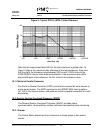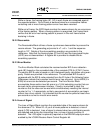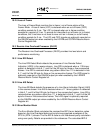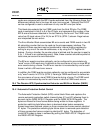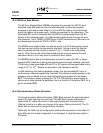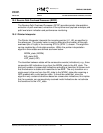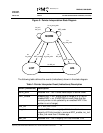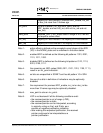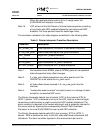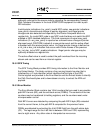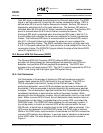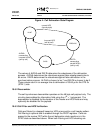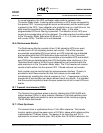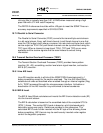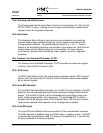
S/UNI-QUAD
PMC-Sierra, Inc.
PM5349 S/UNI-QUAD
DATASHEET
PMC-971239 ISSUE 6 SATURN USER NETWORK INTERFACE (155-QUAD)
Proprietary and Confidential to PMC-Sierra, Inc., and for its Customers’ Internal Use
41
When the received pointer returns to an in-range value, the
S/UNI/QUAD will interpret it correctly.
Note 10 - LOP will exit at the third frame of a three frame sequence consisting
of one frame with NDF enabled followed by two frames with NDF
disabled, if all three pointers have the same legal value.
The transitions indicated in the state diagram are defined in the following table.
Table 2: Pointer Interpreter Transition Description
Transition Description
inc_ind/dec_ind offset adjustment (increment or decrement indication)
3 x eq_new_point three consecutive equal new_point indications
NDF_enable single NDF_enable indication
3 x AIS_ind three consecutive AIS indications
8 x inv_point eight consecutive inv_point indications
8 x NDF_enable eight consecutive NDF_enable indications
Note 1 - the transitions from NORM_state to NORM_state do not represent
state changes but imply offset changes.
Note 2 - 3 x new_point takes precedence over other events and if the
IINVCNT bit is set resets the inv_point count.
Note 3 - all three offset values received in 3 x eq_new_point must be
identical.
Note 4 - "consecutive event counters" are reset to zero on a change of state
except for consecutive NDF count.
The Pointer Interpreter detects loss of pointer (LOP) in the incoming STS-3c
(STM-1) stream. LOP is declared on entry to the LOP_state as a result of eight
consecutive invalid pointers or eight consecutive NDF enabled indications. The
alarm condition is reported in the receive alarm port and is optionally returned to
the source node by signaling the corresponding Transmit Path Overhead
Processor in the local S/UNI-QUAD to insert a path RDI indication.
The Pointer Interpreter detects path AIS in the incoming STS-3c (STM-1)
stream. PAIS is declared on entry to the AIS_state after three consecutive AIS
indications. The alarm condition reported in the receive alarm port and is



